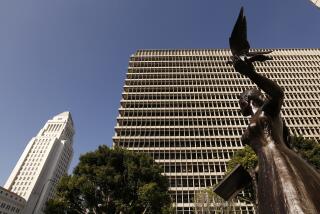Yes, There’s a Glut of Lawyers . . . but Only for the Wealthy : Legal Aid: Many attorneys would help the needy, but there are few jobs and dismal pay. The answer is redistribution of services.
- Share via
Ask almost anyone about lawyers and you’re likely to get the same response--there are too many and they charge too much money. There certainly are more than ever--nearly 800,000, more than three times as many as in 1960. Yet there’s something odd about the popular complaint: If lawyers charge too much, we should produce more of them so that supply can respond to demand and reduce prices.
The real problem with lawyers is the maldistribution of legal services. This isn’t new, but it’s been getting worse. Only one-fifth of lawyer effort is devoted to “personal plight”--problems like personal injury, divorce, criminal defense and civil rights.
The United States spends far less per capita on legal services for the poor than other, less-wealthy countries like Britain, Canada and the Netherlands. Fewer than 1% of American lawyers work in legal-aid or public-defender offices.
There certainly is no shortage of recruits. Competition to enter law school is intensifying. UCLA received more than 6,000 applications last year for a little more than 300 places. And a substantial proportion of entrants are interested in representing the unrepresented; this is particularly true of the growing numbers of women and minority law students. Yet only 3% of 1988 law school graduates embarked on public-interest careers. Why is this?
One reason is the paucity of jobs. Although the number of law school graduates has tripled since 1960, the public-interest sector has been under attack for nearly a decade.
Federal expenditures on legal aid increased dramatically from less than $5 million in 1965 to $320 million in the last year of the Carter Administration. Former President Ronald Reagan, an enemy of legal services since his days as governor of California, sought to terminate the program. Although the Democratic Congress fought back, he was able to cut the budget by one-third and keep it at that level.
Legal services for the poor are clearly not one of President Bush’s thousand points of light or part of a kinder, gentler nation. He has retained the Reagan board of governors, who are dedicated to undermining the program.
Even when there are public-interest jobs, they have to compete with the attractions of corporate practice. This is the fastest-growing sector of the profession: The 200 largest firms employ nearly three times as many lawyers in 1987 as they did just 12 years earlier. Two out of every three 1989 UCLA law graduates joined firms with more than 25 lawyers. The pull is obviously money--starting salaries exceed $80,000 at some firms. But its manifestations are complex.
The gap between incomes in the public and private sectors has grown dramatically. In the mid-1970s, corporate lawyers began at salaries only 50% higher than those earned by legal aid lawyers; now they make more than three times as much. It’s very hard to persuade oneself or others that a job paying one-third the salary of a classmate’s represents a choice, not just bad grades.
The disparity in material and intangible rewards increases with age. Public-interest lawyers in the Netherlands also earn low salaries (although not that much less than those in private practice), but they enjoy state subsidization of child care, housing, health, tertiary education and transportation.
Americans must pay for most of this out of their own pockets. Furthermore, because American legal-aid and public-defender programs are grossly underfunded, their lawyers carry very heavy caseloads. Just as they are denied the material rewards of corporate practice, so they find it harder to reap the psychic rewards of craftsmanship.
Public resentment of lawyers is mirrored by lawyers’ feelings that they are misunderstood and abused. We can only address these related complaints by redistributing legal services. Government must greatly increase the legal-aid budget, to provide services for all who cannot pay and to attract and retain lawyers by offering adequate salaries and decent workingconditions. Legal aid must also be extended to the many middle-class individuals who cannot afford private legal services (but who can and should pay part of the cost).
All lawyers must recognize an obligation to increase access to legal services. If the 99% of lawyers who don’t work in legal aid or public defender offices devoted even 1% of their energies to the poor, they would almost double the services now available. “Equal Justice Under Law”--the promise proclaimed over the entrance to the Supreme Court--demands no less.
More to Read
Sign up for Essential California
The most important California stories and recommendations in your inbox every morning.
You may occasionally receive promotional content from the Los Angeles Times.













